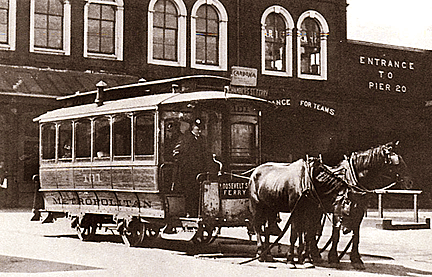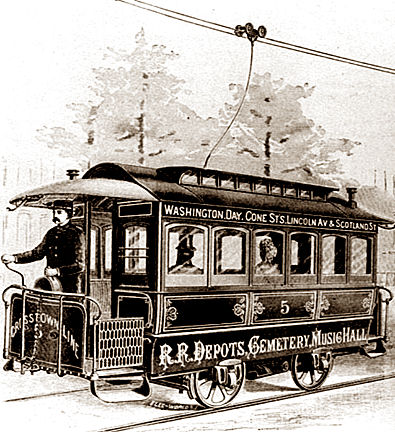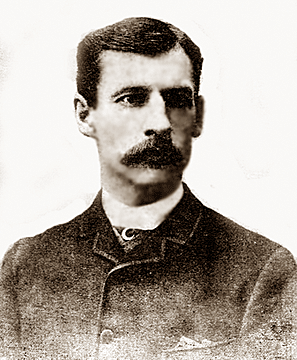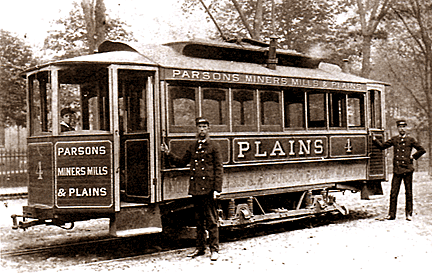|
 No one person invented the trolley. Rebuilt
from horsecars, the earliest electrics were uncertain vehicles. No one person invented the trolley. Rebuilt
from horsecars, the earliest electrics were uncertain vehicles.
Some inventors mounted the motor on the front platform, so
that nothing was more natural than to christen the electrician standing
beside it a "motorman." But since flimsy horsecar platforms showed
a tendency to shake to pieces under this load, they soon moved the motor
down near the wheels. Speeds were low, perhaps eight or nine miles an hour
when all went well.
 A man named Leo Daft invented a system employing two
overhead wires, strung side by side, on which there ran a toy-sized cart or
dolly known as a "troller" or trolley. Flexible wires dangled from
the dolly to the car beneath, which towed it along. However, the Daft system
proved troublesome since the troller kept falling off the wire and landing
with a terrifying crash on the car roof. Consequently, Daft cars tended to
leak in heavy rains causing passengers to keep their umbrellas raised
inside. Daft used crude fuses to save the motors from overloading, but these
fuses could let go with a brilliant yellow flash and a deafening bang,
sending passengers out through the windows. A man named Leo Daft invented a system employing two
overhead wires, strung side by side, on which there ran a toy-sized cart or
dolly known as a "troller" or trolley. Flexible wires dangled from
the dolly to the car beneath, which towed it along. However, the Daft system
proved troublesome since the troller kept falling off the wire and landing
with a terrifying crash on the car roof. Consequently, Daft cars tended to
leak in heavy rains causing passengers to keep their umbrellas raised
inside. Daft used crude fuses to save the motors from overloading, but these
fuses could let go with a brilliant yellow flash and a deafening bang,
sending passengers out through the windows.
Word got around about how trolleys "forced
electricity into the ground," subjecting water pipes to a destructive
corrosion called electrolysis. It was also widely rumored that the blue
sparks flashing from trolley poles were injurious to eyesight.
 Despite tremendous difficulties, a young Annapolis
graduate named Frank Sprague built a 12-mile, 40-car line in Richmond,
Virginia, which began service on February 2nd, 1888. Since both its size and
survival were unprecedented, it quickly attracted the attention of horsecar
officials all over North America. Soon, scores of similar lines appeared
signaling the birth of the electric traction era. Despite tremendous difficulties, a young Annapolis
graduate named Frank Sprague built a 12-mile, 40-car line in Richmond,
Virginia, which began service on February 2nd, 1888. Since both its size and
survival were unprecedented, it quickly attracted the attention of horsecar
officials all over North America. Soon, scores of similar lines appeared
signaling the birth of the electric traction era.
Sprague used and improved the now familiar trolley pole
instead of the 'troller' for power collection and designed a mounting for
the motors that kept the gearing between them and the road wheels in
constant mesh. He also showed that reversing the motors would slow the cars
and bring them to a halt safely. Street railway patronage set new records
every month, and cars grew in size in order to accommodate the riders.
As the industry rapidly grew and matured, the trolley
became part of the fabric of everyday life. On most lines, even in the
smaller cities, car came along every few minutes. On busier routes and in
the larger cities one always seemed to be in sight. During the morning and
evening rush hours, headways, the interval of time between cars, were
measured in inches than in minutes, for companies pressed every car capable
of turning a wheel into service to cope with the peak loads.
 Small towns built systems as short as a mile in length.
And big cities built systems with hundreds of miles of track. Suburbs grew
up all around larger cities because of reliable, all-weather trolley
transportation. Trolleys were everywhere and took people everywhere they
wanted to go. Small towns built systems as short as a mile in length.
And big cities built systems with hundreds of miles of track. Suburbs grew
up all around larger cities because of reliable, all-weather trolley
transportation. Trolleys were everywhere and took people everywhere they
wanted to go.
At first, a different company owned almost every line. So
passengers paid an additional fare each time they changed cars. Around the
turn of the century, a wave of consolidation swept most cities with just one
or two big streetcar companies owning all the routes. These companies soon
discovered that by issuing free transfers between lines, more than enough
additional riders would take the cars to make up for the fares lost.
Ridership soared.
Next:
Those Loveable Trolley Riders
|
